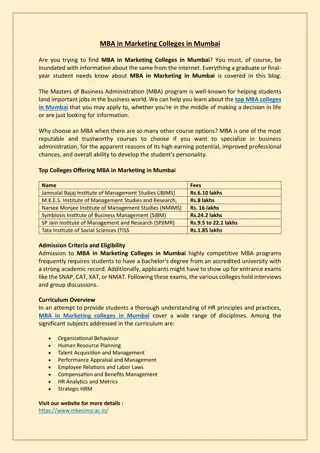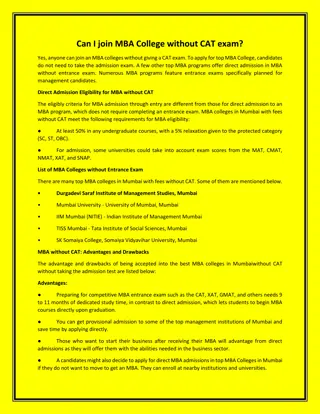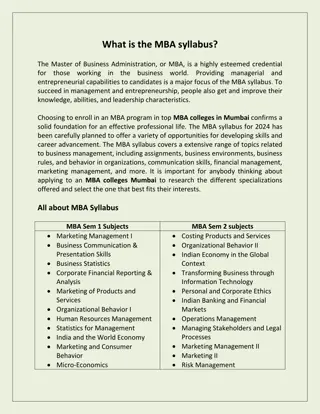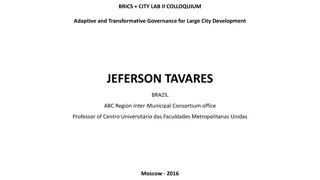
Activity-Based Costing (ABC) Methodology
Discover the key concepts, steps for implementation, advantages, and disadvantages of Activity-Based Costing (ABC) compared to traditional costing methods. Learn how ABC enables accurate cost allocation, improves decision-making, and eliminates non-value-added activities in organizations.
Download Presentation

Please find below an Image/Link to download the presentation.
The content on the website is provided AS IS for your information and personal use only. It may not be sold, licensed, or shared on other websites without obtaining consent from the author. If you encounter any issues during the download, it is possible that the publisher has removed the file from their server.
You are allowed to download the files provided on this website for personal or commercial use, subject to the condition that they are used lawfully. All files are the property of their respective owners.
The content on the website is provided AS IS for your information and personal use only. It may not be sold, licensed, or shared on other websites without obtaining consent from the author.
E N D
Presentation Transcript
ACTIVITY-BASED COSTING (ABC)
INTRODUCTION Definition of Activity-Based Costing (ABC): ABC is a costing methodology that assigns costs to products and services based on the activities required to produce them. Importance of ABC in Cost Management: Helps organizations identify high- cost activities, allocate costs more accurately, and improve decision-making. Comparison with Traditional Costing Methods: Unlike traditional costing, which assigns overhead costs based on labor or machine hours, ABC assigns costs based on actual resource consumption.
KEY CONCEPTS OF ABC Cost Drivers: Factors that cause costs to be incurred (e.g., number of machine setups, labor hours, or batches processed). Activities: Tasks or processes that consume resources and contribute to cost accumulation (e.g., quality inspections, order processing). Resource Allocation: The distribution of costs from resources to activities and then to cost objects. Overhead Distribution: ABC helps distribute indirect costs more accurately compared to traditional methods.
STEPS IN IMPLEMENTING ABC 1. Identify Activities: List all significant activities performed in the production or service process. 2. Assign Costs to Activities: Determine the total cost associated with each activity. 3. Identify Cost Drivers: Establish the factors that influence the cost of each activity. 4. Allocate Costs to Products/Services Based on Usage: Assign costs to products or services based on how much of each activity they consume.
ADVANTAGES OF ABC 1. More Accurate Cost Allocation: Provides a realistic assignment of indirect costs. 2. Better Understanding of Cost Behavior: Helps in analyzing cost patterns and cost reduction opportunities. 3. Improved Decision-Making: Assists in pricing strategies, budgeting, and profitability analysis. 4. Helps in Eliminating Non-Value-Added Activities: Identifies and reduces wasteful activities.
DISADVANTAGES OF ABC 1. Time-Consuming and Expensive to Implement: Requires detailed activity tracking and data collection. 2. Requires Significant Data updates and monitoring. 3. Complex to Maintain and Update: Needs regular adjustments as business processes evolve. Collection: Demands constant
ABC VS. TRADITIONAL COSTING Feature Traditional Costing Activity-Based Costing (ABC) Basis of Allocation Direct labor/machine hours Activity-based cost drivers Accuracy Less accurate More precise cost distribution More detailed and complex but insightful Complexity Simpler and easier to implement Companies with diverse products and processes Best Suited For Companies with uniform products
REAL-WORLD APPLICATIONS 1. Manufacturing Industries: Helps in pricing, cost reduction, and profitability analysis. 2. Service Sector (e.g., Healthcare, Banking): Assists in cost allocation for patient care, loan processing, and other service activities. 3. Retail and Logistics: Enhances supply chain efficiency by identifying high- cost distribution activities. 4. IT & Software Development: Useful for tracking costs related to software development, testing, and maintenance.






















